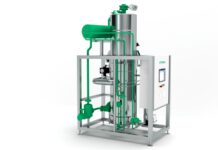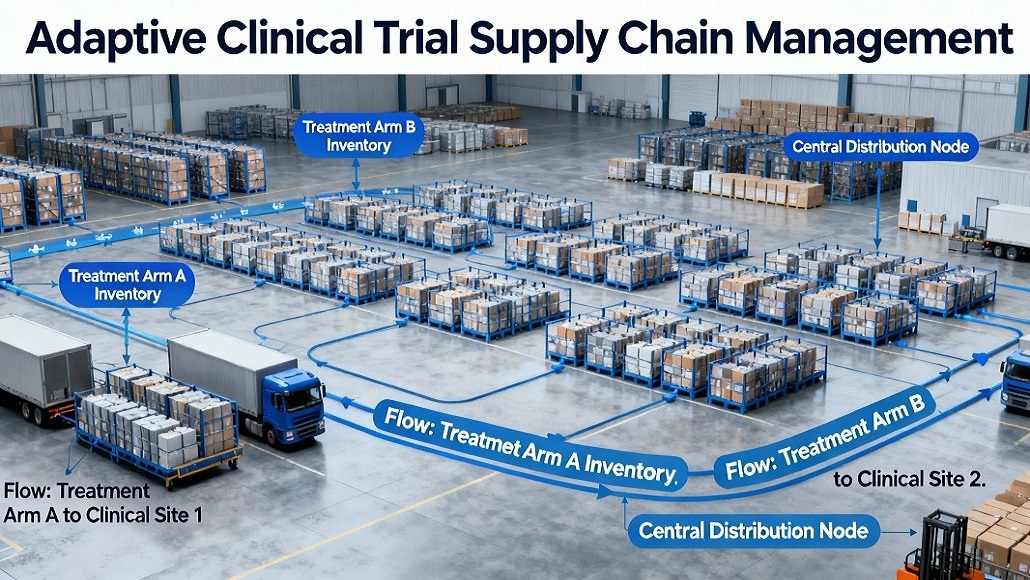The clinical research landscape has undergone a fundamental transformation in recent years, with traditional two-arm trial designs giving way to more sophisticated multi-arm and platform trial structures. These complex study designs demand equally sophisticated supply chain strategies that can adapt to evolving requirements in real-time. Adaptive clinical supply planning has emerged as the critical framework enabling sponsors to navigate the uncertainties inherent in modern clinical development while maintaining efficiency, compliance, and patient focus.
The Evolution Toward Complex Trial Designs
Clinical research has traditionally relied on rigid, predetermined protocols where every aspect of the trial was fixed before the first patient enrollment. This approach, while methodologically sound, often resulted in inefficient resource allocation, extended timelines, and substantial waste when trial parameters needed modification. The advent of adaptive designs, particularly multi-arm multi-stage (MAMS) platform trials, has fundamentally challenged this paradigm.
Shifting from Traditional to Adaptive Models
Platform trials represent a revolutionary approach where multiple treatments are evaluated simultaneously against a shared control arm within a single master protocol. This design offers remarkable efficiencies, finding beneficial treatments with fewer patients, reduced timeframes, and greater probability of success compared to traditional two-arm strategies. The COVID-19 pandemic accelerated adoption of these designs, with landmark studies like the RECOVERY trial demonstrating how adaptive platform approaches could rapidly identify effective interventions during a global health crisis.
However, the flexibility that makes platform trials so powerful also creates unprecedented supply chain complexity. When treatments can be added or dropped based on interim analyses, when randomization ratios shift to favor more promising arms, and when patient enrollment patterns fluctuate unpredictably, traditional supply planning methods quickly become inadequate. This is where adaptive clinical supply planning becomes not merely beneficial but essential.
Core Principles of Adaptive Supply Planning
Embracing Uncertainty as a Design Feature
Adaptive clinical supply planning operates on several foundational principles that distinguish it from conventional approaches. First, it embraces uncertainty as a design feature rather than a flaw. Instead of attempting to forecast every variable with perfect accuracy, adaptive planning builds flexibility into the supply chain itself, creating systems that can respond dynamically to changing trial conditions.
The methodology relies heavily on prospective statistical simulation to optimize trial design and establish clear criteria for adaptations. This requires mapping out the entire development program in advance, considering not just the immediate trial but subsequent phases and potential pivots. Such comprehensive planning demands a cultural shift within organizations accustomed to more siloed, phase-by-phase thinking.
Integration Across Functions
Second, adaptive planning integrates supply considerations directly into trial design decisions. Rather than treating supply chain management as a downstream operational concern, it positions supply flexibility as a core requirement that influences protocol design, randomization strategies, and even therapeutic area selection. This integration ensures that supply limitations never become the bottleneck preventing protocol modifications that could accelerate development or improve patient outcomes.
Data-Driven Decision Making
Third, adaptive approaches leverage real-time data to drive decision-making. Modern Randomization and Trial Supply Management (RTSM) systems provide continuous visibility into enrollment patterns, site inventory levels, and treatment allocation ratios. This data feeds into predictive algorithms that can anticipate supply needs before they become critical, enabling proactive rather than reactive management.
Forecasting Models for Adaptive Trials
Advanced Simulation and Probabilistic Approaches
Clinical trial forecasting in the context of adaptive designs requires sophisticated modeling that accounts for multiple potential scenarios. Traditional forecasting methods, often based on simple spreadsheets, cannot capture the complex interplay of variables in platform trials. Instead, sponsors are turning to advanced simulation tools that can model hundreds or thousands of potential trial paths.
These forecasting models incorporate numerous parameters, including expected site activation rates, patient enrollment curves, screen failure and dropout rates, randomization schemes, stratification factors, and variable dosing requirements. For multi-arm studies, they must also account for potential arm additions or terminations, changes in allocation ratios based on interim efficacy signals, and the possibility of early stopping for futility or success.
The models generate probability distributions for supply requirements across different time points and locations, allowing planners to develop robust strategies that perform well across a range of scenarios rather than optimizing for a single, unlikely perfect forecast. This probabilistic approach inherently acknowledges uncertainty and builds in appropriate buffers without the excessive overage that plagues traditional planning.
Machine Learning Enhancement
Machine learning algorithms are increasingly enhancing these forecasting capabilities by identifying patterns in historical trial data that human analysts might miss. These systems can predict enrollment slowdowns based on seasonal factors, site performance trends, or competitive trial activity, enabling more nuanced supply adjustments. By analyzing thousands of previous trials, machine learning models can identify subtle indicators that correlate with enrollment success or failure, providing sponsors with predictive intelligence to inform adaptive supply decisions.
Adaptive Packaging Strategies
Just-in-Time and On-Demand Models
Packaging represents one of the most significant opportunities for introducing flexibility into clinical supply chains. Traditional approaches manufacture and label all clinical trial materials (CTM) before study initiation, committing product to specific dosing regimens, countries, and label designs. When protocols change, this results in costly and time-consuming repackaging or disposal of unused materials.
Adaptive packaging strategies fundamentally alter this equation. Just-in-time (JIT) and on-demand packaging models postpone labeling and final configuration until materials are actually needed. Bulk drug product is stored in a central location, and only when a site requests supplies are kits assembled, labeled, and shipped. This approach offers several critical advantages for adaptive trials.
Benefits of Adaptive Packaging
First, it dramatically reduces the lead time for implementing protocol changes. When a new arm is added to a platform trial, supplies can be configured and distributed within weeks rather than months. This agility is essential for capturing the benefits of adaptive designs, where the ability to rapidly evaluate new treatments is a primary value driver.
Second, JIT packaging minimizes waste and overage. Traditional forecasting often requires 50-200% overage to account for uncertainties, representing significant cost and resource inefficiency. Adaptive packaging eliminates much of this overage by aligning production precisely with demand, a particularly valuable benefit for expensive biologics or drugs in short supply.
Third, on-demand models enhance inventory flexibility. Bulk materials can be allocated across multiple studies as needed, responding to shifting priorities and enrollment patterns. This is especially valuable for sponsor companies managing portfolios of trials where resource allocation decisions may change based on emerging data.
Randomization Strategies and Supply Implications
Response-Adaptive Randomization
The randomization scheme in adaptive trials has profound implications for supply planning. Platform trials typically use response-adaptive randomization, where allocation ratios shift to favor treatments showing superior efficacy signals. While statistically efficient, this creates dynamic supply requirements that traditional systems struggle to support.
Consider a four-arm platform trial with three experimental treatments and one control. Initial randomization might allocate patients equally across all arms. However, if interim analysis shows one experimental treatment is particularly promising, the allocation ratio might shift to 40% for the promising treatment while maintaining 20% each for the other arms and control. This immediately doubles the supply requirement for the favored treatment while reducing needs for others.
Inventory Management Systems
Adaptive supply planning must therefore maintain sufficient inventory of all treatments to support potential allocation shifts, while avoiding excessive stockpiling of treatments that may be dropped for futility. This requires sophisticated inventory management systems that can track expiration dates, monitor usage rates across arms, and trigger replenishment based on dynamic thresholds.
Advanced RTSM platforms address this challenge through integrated randomization and supply management. These systems maintain real-time visibility into treatment assignments and site inventory, automatically generating shipment requests when stock falls below predetermined levels. For adaptive trials, these thresholds can be configured to adjust automatically based on current allocation ratios, ensuring supply keeps pace with randomized demand.
Supply Agility in Platform Trial Execution
Multi-Level Agility Requirements
The operational execution of adaptive platform trials demands supply agility at multiple levels. At the strategic level, sponsors must design supply networks capable of supporting global trials with diverse regulatory requirements. This often involves establishing regional depots that can serve multiple countries, reducing shipping times and customs delays that could impede rapid protocol modifications.
At the tactical level, study teams need processes for accelerated label development and regulatory approval. When new arms are added, multilingual label booklets must be created, reviewed, and approved across multiple jurisdictions. Preparing template label designs and establishing relationships with regulatory consultants in key markets can compress these timelines from months to weeks.
Operational Excellence and Training
At the operational level, site-facing staff require training on the adaptive aspects of the trial and how these impact supply logistics. Sites must understand that supply deliveries may be more frequent but in smaller quantities, that kit numbers may change based on randomization adjustments, and that inventory management systems will provide dynamic resupply triggers. Clear communication protocols and regular updates ensure sites remain engaged and responsive to supply chain changes.
Technology integration becomes paramount for achieving this agility. Modern clinical supply chains leverage cloud-based platforms that connect manufacturers, depots, sites, and couriers in real-time. These systems enable end-to-end visibility, allowing sponsors to track shipments, monitor temperature excursions, and confirm delivery to sites or directly to patients in decentralized models.
Real-World Implementation Challenges
Regulatory and Organizational Barriers
Despite its compelling benefits, implementing adaptive clinical supply planning faces several practical challenges. Regulatory acceptance, while improving, remains a concern in some markets where authorities are less familiar with adaptive designs. Sponsors must invest in regulatory strategy early, engaging with agencies to explain how supply flexibility supports trial integrity and patient protection.
Organizational culture presents another significant barrier. Many companies have built their supply operations around traditional, batch-oriented processes. Transitioning to adaptive models requires new skill sets, different performance metrics, and greater cross-functional collaboration between clinical operations, supply chain, and statistics departments. Change management efforts must emphasize how adaptive approaches ultimately accelerate timelines and reduce costs, creating enthusiasm for organizational transformation.
Data Quality and System Integration
Data quality and timeliness also critically impact adaptive planning effectiveness. The entire system depends on accurate, up-to-date information about enrollment, randomization, and inventory. Gaps or delays in data can lead to supply shortages or excessive overage, undermining the benefits of the adaptive approach. This necessitates robust data management infrastructure and clear accountability for data entry and verification.
Cost considerations are complex. While adaptive planning reduces waste and overage, it requires investment in more sophisticated systems, additional personnel training, and potentially higher per-unit packaging costs due to smaller batch sizes. Sponsors must take a holistic view, considering total trial cost rather than just supply chain expenses, to appreciate the full value proposition.
Future Directions in Adaptive Supply Planning
Emerging Technologies
The field continues to evolve rapidly, with several emerging trends poised to further enhance adaptive clinical supply planning. Digital twin technology, which creates virtual replicas of physical supply chains, enables sponsors to simulate the impact of potential adaptations before implementing them. This allows for more confident decision-making and optimized supply strategies.
Artificial intelligence is moving beyond forecasting to autonomous supply management. AI systems can now adjust resupply thresholds, reroute shipments based on logistics disruptions, and even recommend protocol modifications to optimize supply utilization. While human oversight remains essential, these tools augment planner capabilities and enable management of increasingly complex trial portfolios.
Decentralized and Sustainable Models
Direct-to-patient (DTP) supply models, accelerated by the COVID-19 pandemic, are becoming integral to adaptive planning. For decentralized and hybrid trials, supplies must reach patients’ homes rather than clinical sites, requiring entirely new logistics capabilities. Adaptive planning frameworks are expanding to incorporate DTP scenarios, with packaging designed for home storage and dispensing, and distribution networks that include pharmacies and specialized couriers.
Sustainability considerations are also shaping adaptive supply strategies. The pharmaceutical industry faces growing pressure to reduce its environmental footprint, and adaptive planning inherently supports this goal by minimizing overproduction and waste. Future developments will likely include more recyclable packaging materials, optimized shipping routes to reduce carbon emissions, and circular economy principles applied to clinical supply chains.
Conclusion
Adaptive clinical supply planning represents a fundamental shift from rigid, predictive models to flexible, responsive systems that embrace the uncertainty inherent in modern clinical development. For multi-arm and platform trials, this approach is not merely advantageous but essential for realizing the full potential of these innovative designs.
Success requires investment in technology, organizational change management, and new capabilities, but the returns are substantial. Trials can be executed more efficiently, with less waste, shorter timelines, and greater probability of success. Perhaps most importantly, patients benefit through faster access to effective treatments and reduced exposure to ineffective ones.
As the industry continues moving toward more complex, adaptive trial designs, supply chain excellence will increasingly differentiate successful development programs from those that struggle with operational execution. Organizations that master adaptive clinical supply planning will gain a significant competitive advantage, accelerating their pipelines while maintaining the highest standards of quality and compliance.




















